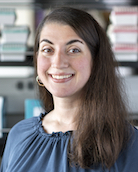
Research Interests:
Polarized epithelial membrane traffic and epithelial morphogenesis.
Summary:
How do individual cells organize to form a multicellular tissue? An individual cell can exhibit many different behaviors – proliferation, migration, adhesion, polarization, differentiation, and death. But to build a tissue, a population of cells must coordinate these individual behaviors across space and time. Little is understood about the mechanisms that orchestrate the actions of single cells during morphogenesis. To analyze these issues, we are studying how epithelial cells form three-dimensional organs. Epithelia are coherent sheets of cells that form a barrier between the interior of the body and the outside world. Internal epithelial organs contain two types of building blocks, cysts and tubules. Our experimental strategy uses culture of epithelial cells in a three-dimensional extracellular matrix. Single cells plated in matrix grow to form hollow cysts lined by a monolayer of cells. We have discovered a pathway containing the small GTPase, rac1, alpha1-beta3 integrin, and laminin, which coordinates cell polarity, so that apical surfaces of the cells are all oriented towards the cyst lumen. Cysts are remodeled into by growth factors, which cause transient dedifferentiation and migration, followed by redifferentiation into polarized epithelial cells lining the tubule.
Spatial asymmetry is fundamental to the structure and function of most eukaryotic cells. A basic aspect of this polarity is that the cell’s plasma membrane is divided into discrete domains. The best studied and simplest example of this occurs in epithelial cells, which line exposed body surfaces. Epithelial cells have an apical surface facing the outside world and a basolateral surface contacting adjacent cells and the underlying connective tissue. These surfaces have completely different compositions. Epithelial cells use two pathways to send proteins to the cell surface. Newly made proteins can travel directly from the trans-Golgi network (TGN) to either the apical or basolateral surface. Alternatively, proteins can be sent to the basolateral surface and then endocytosed and transcytosed to the apical surface. We are studying the machinery that is responsible for the specificity and regulation of polarized membrane traffic in epithelial cells. I will discuss several recent results.
1. The SNARE hypothesis provides a unified model for how intracellular vesicular targeting and fusion work. Proteins on transport vesicles, known as v-SNAREs, pair with corresponding t-SNAREs on target membranes, leading to vesicle fusion. The correct pairing of particular v- and t-SNAREs can provide a mechanism for specificity of targeting and fusion. Polarized epithelial cells are an ideal system in which to test the role of SNAREs in specificity, as these cells contain two plasma membrane targets, the apical and basolateral surfaces, as well as multiple classes of vesicles traveling to each surface. We have found that that the t-SNARE syntaxin 3, is involved with transport to the apical surface, while the related t-SNARE, syntaxin 4, is utilized for transport to the basolateral surface.
2. The polymeric immunoglobulin receptor (pIgR) transcytoses IgA from the basolateral to the apical surface. Transcytosis is stimulated by ligand binding. Binding of IgA causes dimerization of the pIgR, which leads to activation of a non-receptor tyrosine kinase, p62Yes. Mice knocked out for this kinase are deficient in IgA transport. Phosphatidylinositol-specific phospholipase C gamma is activated, resulting in production of DAG and IP3. The DAG activates protein kinase Ce, which stimulates transcytosis. The IP3 raises intracellular free calcium, which also stimulates transcytosis. Stimulation of transcytosis also involves the small GTPase, rab3b, which directly interacts with the pIgR.
3. When epithelial cells, such as MDCK cells, are plated in a 3 dimensional collagen matrix, the cells form hollow, polarized cysts with the apical surface facing the lumen of the cyst. Overexpression of a dominant negative form of the small GTPase, rac, retards lumen formation and leads to a partial reversal of polarity, with the apical surface oriented towards the outside of the cyst. Growth of the cysts laminin rescues this phenotype, indicating that interfering with rac function interferes with the ability of the cell to assemble, laminin, which normally provides a spatial cue.
4. When collagen-grown cysts are stimulated with hepatocyte growth factor (HGF), the cysts develop branching tubules, providing a simple model system for studying tubulogenesis. The exocyst is an eight-subunit complex involved in targeting transport vesicles to specific regions of the plasma membrane. We have found that HGF treatment causes the exocyst to relocalize from the region of the tight junction to the growing tubule, indicating that new membrane is being directed to the tubule. Overexpression a subunit of the exocyst, hSec10, causes the cysts to elaborate an increased umber of tubules, indicating a direct connection between membrane traffic and tubulogenesis.
UCSF Profiles Page










